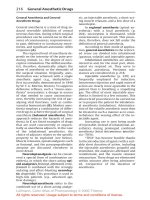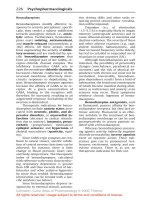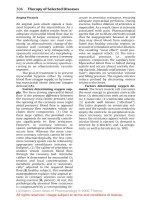An Atlas of Diagnostic Nasal Endoscopy
Bạn đang xem bản rút gọn của tài liệu. Xem và tải ngay bản đầy đủ của tài liệu tại đây (9.72 MB, 208 trang )
Cover
Page i
An Atlas of DIAGNOSTIC NASAL ENDOSCOPY
Page ii
This page intentionally left blank.
Page iii
THE ENCYCLOPEDIA OF VISUAL MEDICINE SERIES
An Atlas of DIAGNOSTIC NASAL ENDOSCOPY
Salah D.Salman, MD, FACS
Surgeon
Director of the Sinus Center
Massachusetts Eye and Ear Infirmary
Lecturer, Department of Otology & Laryngology
Harvard Medical School
Boston, Massachusetts, USA
Formerly
Professor & Chairman, Department of Otolaryngology
American University of Beirut
Lebanon
The Parthenon Publishing Group
International Publishers in Medicine, Science & Technology
A CRC PRESS COMPANY
BOCA RATON LONDON NEW YORK WASHINGTON, D.C.
Page iv
Published in the USA by
The Parthenon Publishing Group Inc.
345 Park Avenue South, 10th Floor
New York
NY 10010
USA
Published in the UK and Europe by
The Parthenon Publishing Group
23–25 Blades Court
Deodar Road
London SW15 2NU
UK
Copyright © 2004 The Parthenon Publishing Group
Library of Congress CataloginginPublication Data
Data available on application
British Library Cataloguing in Publication Data
Salman, Salah D.
An atlas of diagnostic nasal endoscopy.—(The encyclopedia of visual medicine series)
1. Nasoscopy—Atlases 2. Nose—Diseases—Diagnosis—Atlases
I. Title
616.2′1207545
ISBN 0203490606 Master ebook ISBN
ISBN 0203623932 (OEB Format)
ISBN 184214233X (Print Edition)
First published in 2004
This edition published in the Taylor & Francis eLibrary, 2005.
To purchase your own copy of this or any of Taylor & Francis or Routledge’s collection of thousands of eBooks please go to www.eBookstore.tandf.co.uk.
No part of this book may be reproduced in any form without permission from the publishers
except for the quotation of brief passages for the purposes of review
Composition by The Parthenon Publishing Group
Page v
Contents
Introduction
1
5
SECTION I: NORMAL AND VARIANTS
Chapter 1. The nostrils and the anterior nasal cavities
Chapter 2. The normal septum
7
13
Chapter 3. The olfactory slits
Chapter 4. The floor of the nose and the inferior meati
19
23
Chapter 5. The inferior turbinates
Chapter 6. The middle meati and the agger nasi
29
35
Chapter 7. The middle turbinates
Chapter 8. The superior turbinates and meati
45
53
Chapter 9. The sinus ostia
Chapter 10. The posterior choanae
Chapter 11. The mucociliary clearance
59
65
69
Chapter 12. Peculiarities of the nasal cavities
73
83
SECTION 2: PATHOLOGY
Chapter 13. The abnormal septum
Chapter 14. Epistaxis
85
95
Chapter 15. Rhinosinusitis
Chapter 16. Polyps
99
109
Page vi
Chapter 17. Systemic diseases
121
Chapter 18. Miscellaneous
129
Chapter 19. Tumors
139
Chapter 20. Operative pictures
157
Chapter 21. Postoperative pictures
169
Chapter 22. Pathologies likely to be missed without nasal endoscopy
183
195
Index
Page vii
Acknowledgements
I am grateful to Rich Cortese of the Department of OtolaryngologyHead and Neck Surgery at the Massachusetts Eye and Ear Infirmary for his help with image
preparation.
This Atlas would not have been possible without Linda Sheehan, RN, Jenecia George, medical assistant, and Mary Tassy, RN, whose dedication, patience, and
friendship over so many years facilitated the taking of hundreds of endoscopic pictures, even during very busy clinics.
I am also grateful for the editorial work graciously provided by Helena Kurban, Terry and Najla Prothro.
Page viii
This work is dedicated to
the memory of my parents who first introduced me to the pleasure of giving.
My father Dr Daoud Salman gave daily at home and in his clinical work.
My mother Zahia Salman gave abundantly to six of us and later to the children of Lebanon.
Page 1
Introduction
The introduction of the Hopkins fiberoptic telescope into offices and operating rooms must be credited for major advances in the diagnosis and the treatment of
rhinological disorders. Their routine office use, which the author strongly advocates, has permitted the appreciation of the quite variable intranasal anatomy, and the
early recognition and diagnosis of abnormalities and pathologies encountered in the practice of Otolaryngology and Rhinology.
Atlases of endoscopic sinus surgery and ENT endoscopy are numerous, but libraries are still lacking a comprehensive uptodate atlas dedicated to nasal
endoscopy. The first and only such atlas, written in German by Walter Messerklinger of Graz, Austria, was translated into English in 1978. It is hoped that this work
fills the gap and becomes a base upon which to build, so that all possible variants and pathologies seen on nasal endosopy become recognizable.
The aim of this Atlas is to familiarize the readers with the numerous normal variants of intranasal anatomy, and with many abnormalities and pathologies encountered
in clinical practice. The emphasis is on recognition of the normal, the normal variants, and the pathology as well as on diagnosis. This Atlas does not discuss treatment.
The pictures shown were all taken by the author over a 15year period, during his practice at a major tertiary care referral center, the Massachusetts Eye and Ear
Infirmary in Boston, Massachusetts. Each picture, with its concise caption, carries a clear and independent teaching message. The format adopted allows leisurely
reading.
Page 2
This page intentionally left blank.
Page 3
Section 1
Normal and variants
Page 4
This page intentionally left blank.
Page 5
SECTION 1
Normal and variants
The anatomy of the nasal cavities is probably the most varied in the human body. Normal variants are numerous, and some of them have been suspected to play a
role in the pathogenesis of sinusitis. It is not within the scope of this Atlas to debate this issue. The author, however, does not think that there is enough evidence to
confirm this suspicion or hypothesis.
Office nasal endoscopy and computed tomography scanning have allowed an adequate familiarization with the normal nasal cavities and their variations, and with the
appearance of the various pathologies that may involve them.
The variations involve the surface appearance of the mucosa and its thickness, and also the size, shape, and color of all the intranasal structures. Familiarization with
all variations is necessary so that the examiner may recognize significant abnormalities and pathologies.
The nasal mucosa is supplied with a rich network of blood vessels whose calibers change frequently under the influence of different internal and external factors,
affecting the size of the airways available for air movement during nasal breathing. It is also supplied with a large number of minor saliva glands, to keep it wet and to
facilitate the mucociliary clearance necessary for proper function. Allergies, infections, and other causes of inflammation do affect the volume, the color, and the
consistency of the secretions, which may then become symptomatic.
Page 6
This page intentionally left blank.
Page 7
CHAPTER 1
The nostrils and the anterior nasal cavities
The nostrils are usually symmetrical but their size varies in different individuals and races. They may be small or large, round or oval. Size does not seem to correlate
with the patency of the nasal passages. Slightly more posterior pathologies are usually responsible for nasal blockage. Contraction of the small anterior facial muscles
causes dilatation of the nostrils. In facial paralysis, the ipsilateral nostril may decrease in size and cause a feeling of blockage. However, nasal blockage is not a
prominent symptom of facial paralysis.
The angle between the septum and the upper lateral cartilage, the socalled nasal valve, plays an important role in maintaining patency during nasal breathing. The soft
tissues lateral to it are more easily collapsible by the negative pressure generated by inspiration and sniffing, than are the stiffer nasal alae. The specially designed
stainless steel strips (‘Breathe Right’, CNS, Inc., Chauhassen, MN, USA), when applied on the dorsum, widen the valve angles by their lateral pull and understandably
result in a feeling of better nasal patency, even in normal subjects. This explains their popularity among football players. An anterior and superior septal deviation may
contribute to the narrowing of the nasal valve.
The anterior nasal cavities may likewise be narrowed by a dislocation of the septal cartilage from the vomer, or by lateral flaring of the medial crura of the alar
cartilages, or even by enlarged tips of the inferior turbinates. The latter may be due to congestion, edema, thick mucosa, or a large cancellous turbinate bone.
Anterior rhinoscopy is usually adequate to evaluate the nostrils and the anterior nasal cavities. However, because of the superiority of the lighting system of
endoscopes, more details may be appreciated by endoscopy.
Page 8
Figure 1.1 Narrow nostrils in a subject with no nasal blockage
Figure 1.2 Wider nostrils in a subject with no nasal blockage
Figure 1.3 Still wider nostrils in another asymptomatic subject
Figure 1.4 Very wide nostrils, short columella, and no nasal tip cartilage support in a subject who had no nasal complaints
Figure 1.5 The base of the columella is widened by the flaring of the medial crura of the alar cartilages. This widening may or may not
contribute to nasal blockage
Figure 1.6 A common appearance of a normal external nose
Page 9
Figure 1.7 The left nasal valve of the subject in Figure 1.6 as seen on endoscopy. The short arrow points to the upper lateral cartilage
and the long arrow to the septum
Figure 1.8 A ‘Breathe Right’ strip applied to the nose of the same subject. Note the resulting ballooning of the soft parts of the nasal
walls
Figure 1.9 The endoscopic picture of the left nasal cavity of the same subject, after application of the ‘Breathe Right’ strip. Note the
wider nasal valve as compared to the one in Figure 1.7. The short arrow points to the upper lateral cartilage and the long arrow
to the septum
Figure 1.10 A right nasal valve pictured during prolonged sniffing. Notice the collapse of the lateral nasal wall (short arrow) on the
septum (long arrow)
Figure 1.11 A right superior septal deviation (arrow) narrowing the nasal valve
Page 10
Figure 1.12 A severe anterior and superior right septal deviation (short arrow) blocking access to the nasal valve. Note the crust (long
arrow) due to the daily nosepicking that the patient practiced in his futile attempt to open up the right nasal cavity for better
breathing. Chronic nose picking causes a squamous metaplasia of the respiratory epithelium. The new epithelium has no cilia
and hence the normal secretions are not moved back; they stay in place, dry, and crust
Figure 1.13 A nasal papilloma on the inner surface of the right nasal ala. When the speculum is removed, the papilloma narrows the
valve area enough to produce symptoms of blockage
Figure 1.14 A left anterior septal dislocation of a too long septal cartilage. Note how it blocks part of the airway
Figure 1.15 The CT appearance of the left anterior septal dislocation (short arrow) from the vomer (long arrow) shown in Figure 1.14
Figure 1.16 Normally, the septal cartilage (short arrow) sits on a Ushaped anterior part of the vomer (long arrow), which is more
commonly Vshaped
Page 11
Figure 1.17 A congested anterior tip of the right inferior turbinate narrowing the airway
Figure 1.18 A depressed nasal fracture in a patient who complained of left nasal blockage
Figure 1.19 The endoscopic appearances of the fractured and depressed left nasal bone (short arrow) which narrows the airway of the
patient in Figure 1.18. The long arrow points to the septum
Figure 1.20 A right anterior nasal stenosis in a patient with pemphigus. The short arrow points to the inner skin of the nasal ala and the
long arrow to the septum
Figure 1.21 Another right anterior nasal stenosis, a complication of a septorhinoplasty
Page 12
This page intentionally left blank.
Page 13
CHAPTER 2
The normal septum
The nasal septum is rarely straight in adults. Deviations and dislocations are very common. These may be unilateral or bilateral, and may involve the septal cartilage, the
vomer, and/or the perpendicular plate of the ethmoid. They may be smooth, or sharp in the form of spurs. When severe, they interfere with nasal breathing. The line
between deviations that need to be considered within normal limits, and those that require surgical correction to improve nasal breathing, is not always clearcut.
The posterior part of the vomer is very rarely deviated.
The color and the vascularity of the septal mucosa vary, as is the case elsewhere in the nose. Prominent vessels on the anterior septum are often the cause of anterior
epistaxis. Posterior prominent vessels, usually veins, have not been suspected to cause nosebleeds.
Mucosal grooves and folds are common. The latter may be prominent enough to look like septal turbinates. These may be primary, or secondary if they develop
after turbinate resections. This phenomenon is most common after middle turbinectomies. Grooves may also involve the septal cartilage and/or bone, as is seen in cases
of severe contralateral spurs.
Page 14
Figure 2.1 A mild superior right septal deviation (short arrow) not obstructing the access to a paradoxical middle turbinate (long arrow)
Figure 2.2 A mild left superior septal deviation, a nonsignificant and common observation
Figure 2.3 A left bonycartilaginous sharp spur (short arrow) touching the inferior turbinate (long arrow). The arrowhead points to the
middle turbinate
Figure 2.4 A groove (short arrow) on the right side, between the septal cartilage (arrowhead) and the vomer (long arrow) of the same
subject shown in Figure 2.3
Figure 2.5 An uncommon cartilaginous protrusion on the right side
Figure 2.6 A mucosal groove seen on the left posterior part of the septum
Page 15
Figure 2.7 A longer groove seen on the right side of the septum (short arrows). The mucosal swelling seen above it (long arrow)
resembles a turbinate. The arrowhead points to the middle turbinate
Figure 2.8 A CT scan of a normal subject with two small septal turbinates on each side
Figure 2.9 A mucosal swelling on the left posterosuperior edge of the vomer
Figure 2.10 The CT scan of the subject in Figure 2.9 showing the mucosal swellings on both sides
Figure 2.11 A right secondary septal turbinate that developed a couple of months after a middle turbinectomy
Page 16
Figure 2.12 A patient who had had bilateral inferior turbinectomies years before (arrows). Note the absence of any septal turbinate
Figure 2.13 A mild right septal deviation in a normal subject (short arrow). Note the circular candy (long arrow) that the patient kept in
her mouth while being scanned!
Figure 2.14 Bilateral nasal septal deviations (arrows) in an asymptomatic subject









